美国概况Chapter 2
- 格式:ppt
- 大小:1.54 MB
- 文档页数:31
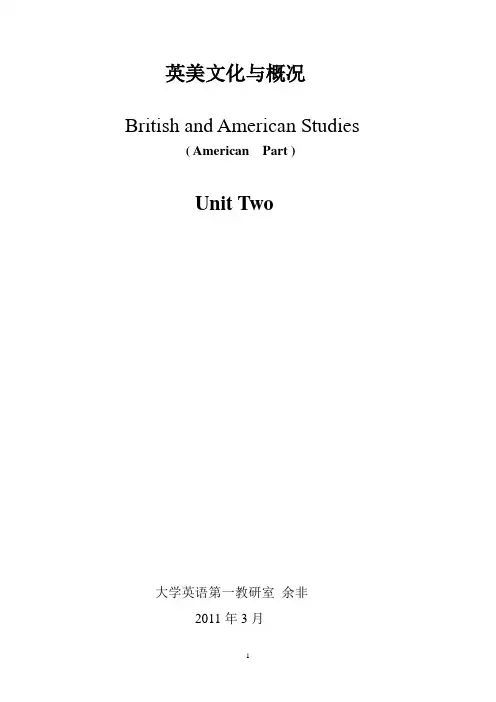
英美文化与概况British and American Studies( American Part )Unit Two大学英语第一教研室余非2011年3月American PartUnit 2 Government System in USA2.1 US Government PrinciplesThe basic principle of US government system comes from Lock e’s political ideas, who maintain only by making good use of human reason could society achieve a continuous progress.First Principle:Sovereignty resides with the people.1. Government of the people, by the people, for the people.-- Abraham Lincoln2. The government gets its just power from the consent of the people, and the government cannot govern without the agreement of the governed.3. People are expected to accept the decision made by the majority.Second Principle:Government has only limited power.1. Government even in its best state is but a necessary evil. --Thomas Paine2.The government has no other powers except those given by the people, or thepower laid down in the constitution.Third Principle:Checks and Balances1.The power given to government is divided between the federal and stategovernment.2.The power granted to each government is sub-divided among the three branchesof government, the legislative, the executive and the judicial. Each branch can check or block the actions of the other branches.Forth Principle:Free exchange of opinions must not be restricted1. The US Constitution protects freedom of speech and freedom of the press so that common people can make their opinions known.2. To prevent government from manipulating public opinion, the law forbids the government to run newspapers and radio stations, nor is it allowed to control school. 2.2 Separation of Power in US Government2.2.1 Structure of US Federal Government ( See PPT 7 )2.2.2 Three BranchesExecutive BranchThe Constitution charges the federal government with handling questions affecting people throughout the nation1. Object to the Bill passed by congress2. Bring up with a bill3. Implement policies. The Constitution empowers the federal government to do all things “necessary and proper” for carrying out its listed duties.Legislative Branch (Congress)✧Functions of Congress1. The central function is to make federal laws2. Collect taxes and levy duties3. pay national debts4. regulate foreign commerce5. raise armies and pay for them6. make investigations: hold hearings on matters of general public concern.✧The US Congress is divided into two chambers, the Senate and the House ofRepresentatives.1. The House of Representatives is commonly known as the House. It has hada permanent membership of 435 since 19102. The whole country is divided into 435 congressional districts, with each district electing one Congressman.3. The life of congress is two years, and Representatives come up for reelection every two years; however, there is no limit on the number of terms.✧The two chambers are granted equal powers for making federal laws, but eachhas some exclusive power that does not share with the other.✧The exclusive power held by the House of Representatives1.Impeachment2.Initiation of revenue bill✧The exclusive power held by the Senator1. to ratify or reject proposed treaties with foreign countries.2. to confirm or reject important nominations proposed by the president3. to hear charges filed by the House against the president for alleged wrongdoings.* The presiding officer of the senate is the Vice-president of the United States who serves as chairman when the Senate is in session.✧Legislative Procedure ( See PPT 13)✓filibuster: ~ is a method used by members of a legislature to prevent the passage of a bill by making tedious speeches✓closure: ~ is to limit debate on a draft bill. If three-fifths of the Senators agree to invoke closure, no senator may speak for more than one hour on the bill under debate.✓presidential veto: The veto of president is overridden if Congress insist on the bill and passed it again by 2/3 majorityJudicial Branch (Federal Law Court)Federal law court have jurisdiction over cases arising out of the constitution, all laws and treaties of the United States, issues involving foreign citizens and governments.1. The supreme Court can determine whether acts passed by Congress or actions taken by the executive branch conform to the spirit of the Constitution.2. It has the authority to stop any actions of the legislative and executive branches by declaring them unconstitutional.2.2.3 Relationships between three Branches ( See PPT 16)。
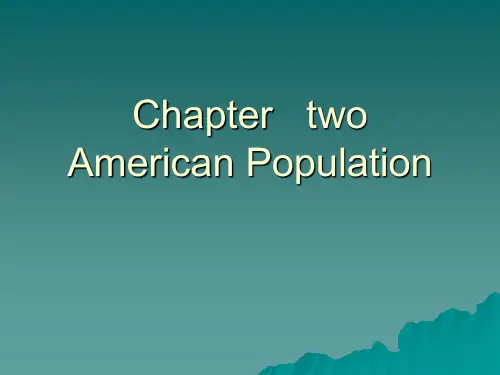
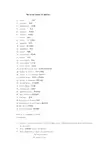
The United States of America1.plain 平原2.plateaus 高原3.predominant 占优势4.glacier 冰川5.tropical 热带的6.borough 行政区7.refine 提炼8.census 人口普查9.immigrant 移民10.ethnic 种/民族的11.amalgamate 同化12.strait 海峡13.reservation 居留地14.famine 饥荒15.assimilation 吸收16.Great Plain 大平原17.Arctic Ocean 北冰洋d subtropical zone 温和的亚热带气候19.Statue of Liberty 自由女神像20.center of oil-refining 炼油中心U.S.Census Bureau 美国人口普查局21.nation of immigrant 移民国家22.Bering Strait 百令海峡23.Great Famine 大饥荒24.melting pot 大熔炉25.Immigration Act 移民法案26.Gulf of Mexico 墨西哥湾27. New Deal 新政28.abolition of slavery 废奴29.Emancipation of proclamatio解放宣言30.the Allies 同盟国31.the U.S.hegemony 美国霸权Chapter 1. Geography & PeopleI.Geography1.Location. In the central part of North of America,It’s bordered by Canada on the north,Nexicoon the south.2.Area, 95000000 square kilometers3.Three geographical ares: the eastern partThe western partThe Great Plain4.Ist mountain: the Rocky Mountains落基山5.Ist river: The Mississippi River,3780kilometers6.Ist lake: lake Superior 苏必利尔湖7.Ist fall: Niagara Fall尼亚加拉大瀑布8.Climate:mild subtropical zone(温和的亚热带气候)9.Major cities: Ist. New York2nd. Los Angeles3rd. Chicago10.Capital: Washington D.C.11.Religions:Christian(Protestant新教徒57%)Catholic 28%IslamBuddist 佛教II.People1.Population: 300million (in 2006)2.Race: white people 74.7%Blacks 12,1%Asians 4.3%Others 6%3.Nation of immigrantsChapter 2. HistoryI.America in the Colonial Era(1607-1776)In 1492,Christopher Columbus,who was financed by the Spanish King and Queen, is believed to have discovered America.Since then,many Europeans set food on this large continent, they called it “the New World”.1)Jamestown 詹姆斯城:The 1st successful English colony was found at Jamestown,Virginia,in 1607 bya team from the London Company.2)Pilgrim Father清教徒前辈移民:in 1620,a group of Puritans including poor farmers amd workers,who were later called the Pilgrim Father,sailed for Virginia on a ship called the Mayflower. They had been persecuted in England because they refused to abide the rules of the Church of England(英国教会)。
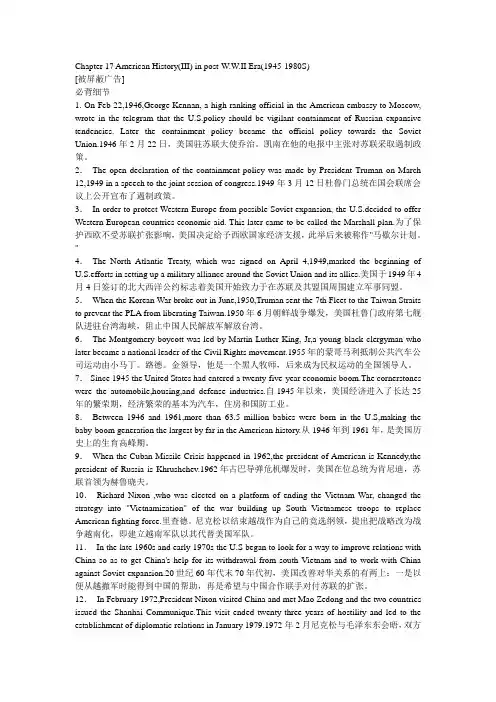
Chapter 17 American History(III) in post-W.W.II Era(1945-1980S)[被屏蔽广告]必背细节1. On Feb 22,1946,George Kennan, a high-ranking official in the American embassy to Moscow, wrote in the telegram that the U.S.policy should be vigilant containment of Russian expansive tendencies. Later the containment policy became the official policy towards the Soviet Union.1946年2月22日,美国驻苏联大使乔治。
凯南在他的电报中主张对苏联采取遏制政策。
2.The open declaration of the containment policy was made by President Truman on March 12,1949 in a speech to the joint session of congress.1949年3月12日杜鲁门总统在国会联席会议上公开宣布了遏制政策。
3.In order to protect Western Europe from possible Soviet expansion, the U.S.decided to offer Western European countries economic aid. This later came to be called the Marshall plan.为了保护西欧不受苏联扩张影响,美国决定给予西欧国家经济支援,此举后来被称作"马歇尔计划。
"4.The North Atlantic Treaty, which was signed on April 4,1949,marked the beginning of U.S.efforts in setting up a military alliance around the Soviet Union and its allies.美国于1949年4月4日签订的北大西洋公约标志着美国开始致力于在苏联及其盟国周围建立军事同盟。
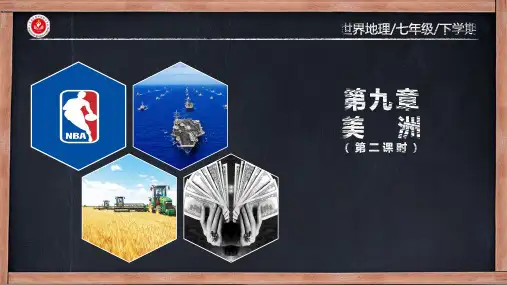
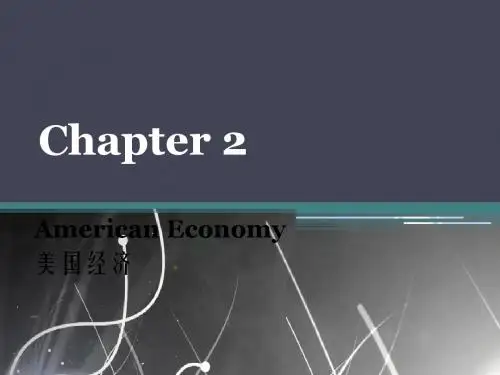
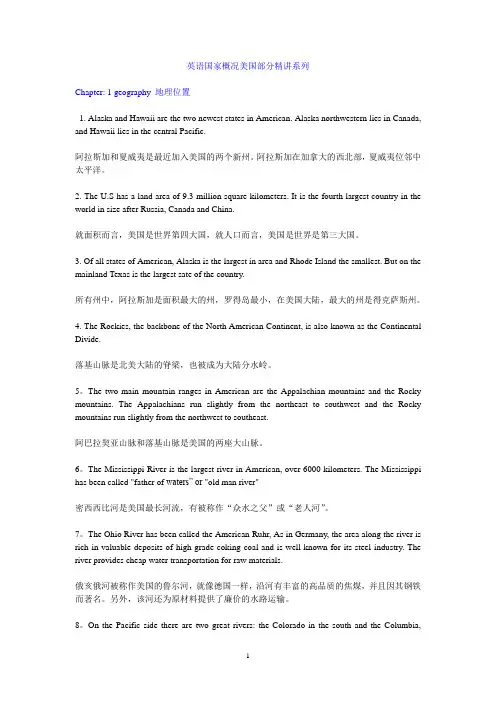
英语国家概况美国部分精讲系列Chapter: 1 geography 地理位置1. Alaska and Hawaii are the two newest states in American. Alaska northwestern lies in Canada, and Hawaii lies in the central Pacific.阿拉斯加和夏威夷是最近加入美国的两个新州。
阿拉斯加在加拿大的西北部,夏威夷位邻中太平洋。
2. The U.S has a land area of 9.3 million square kilometers. It is the fourth largest country in the world in size after Russia, Canada and China.就面积而言,美国是世界第四大国,就人口而言,美国是世界是第三大国。
3. Of all states of American, Alaska is the largest in area and Rhode Island the smallest. But on the mainland Texas is the largest sate of the country.所有州中,阿拉斯加是面积最大的州,罗得岛最小,在美国大陆,最大的州是得克萨斯州。
4. The Rockies, the backbone of the North American Continent, is also known as the Continental Divide.落基山脉是北美大陆的脊梁,也被成为大陆分水岭。
5。
The two main mountain ranges in American are the Appalachian mountains and the Rocky mountains. The Appalachians run slightly from the northeast to southwest and the Rocky mountains run slightly from the northwest to southeast.阿巴拉契亚山脉和落基山脉是美国的两座大山脉。
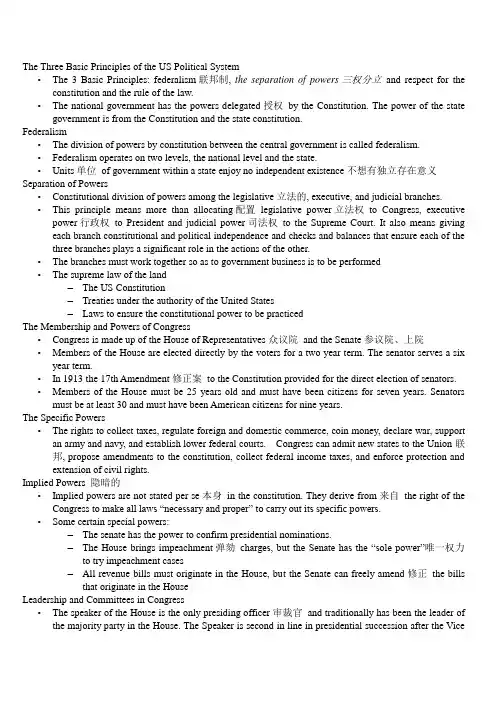
The Three Basic Principles of the US Political System•The 3 Basic Principles: federalism联邦制, the separation of powers三权分立and respect for the constitution and the rule of the law.•The national government has the powers delegated授权by the Constitution. The power of the state government is from the Constitution and the state constitution.Federalism•The division of powers by constitution between the central government is called federalism.•Federalism operates on two levels, the national level and the state.•Units单位of government within a state enjoy no independent existence不想有独立存在意义Separation of Powers•Constitutional division of powers among the legislative立法的, executive, and judicial branches.•This principle means more than allocating配置legislative power立法权to Congress, executive power行政权to President and judicial power司法权to the Supreme Court. It also means giving each branch constitutional and political independence and checks and balances that ensure each of the three branches plays a significant role in the actions of the other.•The branches must work together so as to government business is to be performed•The supreme law of the land–The US Constitution–Treaties under the authority of the United States–Laws to ensure the constitutional power to be practicedThe Membership and Powers of Congress•Congress is made up of the House of Representatives众议院and the Senate参议院、上院•Members of the House are elected directly by the voters for a two year term. The senator serves a six year term.•In 1913 the 17th Amendment修正案to the Constitution provided for the direct election of senators.•Members of the House must be 25 years old and must have been citizens for seven years. Senators must be at least 30 and must have been American citizens for nine years.The Specific Powers•The rights to collect taxes, regulate foreign and domestic commerce, coin money, declare war, support an army and navy, and establish lower federal courts. Congress can admit new states to the Union联邦, propose amendments to the constitution, collect federal income taxes, and enforce protection and extension of civil rights.Implied Powers 隐暗的•Implied powers are not stated per se本身in the constitution. They derive from来自the right of the Congress to make all laws “necessary and proper” to carry out its specific powers.•Some certain special powers:–The senate has the power to confirm presidential nominations.–The House brings impeachment弹劾charges, but the Senate has the “sole power”唯一权力to try impeachment cases–All revenue bills must originate in the House, but the Senate can freely amend修正the bills that originate in the HouseLeadership and Committees in Congress•The speaker of the House is the only presiding officer审裁官and traditionally has been the leader of the majority party in the House. The Speaker is second in line in presidential succession after the VicePresident副总统.•The Vice President is the presiding officer and is called the president of the Senate. He seldom appears in the Senate chamber堂、会所in this role unless it appears that there might be tie vote in the Senate.He casts the tiebreaking vote. To deal with day to day business, the Senate chooses the president pro tempore.How a Bill Becomes a Law•When bills are introduced引进, they are sent to the appropriate committees by the Speaker of the House or the Senate majority leader.•The chair of the committee sends the bill to a subcommittee小组委员会where hearings听证会are held.•The subcommittee issues a report that is either favorable or unfavorable to the bill. Or it may report out an amended修正的or changed bill or rewrite the original bill.• A bill favorably reported out of a Senate committee is put on the calendar for floor action.•In the House bills must first go through the Rules Committee规则委员会, which decides when the full house will hear the bill.• A senator who wants to delay延期action on a bill or kill it may use a tactic策略called a filibuster阻挠议事行动. It can be cut off only through cloture讨论终结.•Then the bills are sent to the President.•If the President does not sign or veto否决a bill within ten days, the bill becomes law.•The bill is dead if Congress adjourns延期within this ten day period. This is known as a pocket veto 搁置否决权. Congress can override推翻the veto by a two thirds vote of both houses.•Lobbying游说is part of the citizen’s right to petition请愿government in the US. Now there are thousands of lobbyists游说者in Washington D.C. (mostly corporate/rich individual lobbyists).Their influence in making US policy is so great that some peopl e call them “the third house” of Congress. Notes•Standing Committees常务委员会: They are permanent ones to determine whether proposed legislation should be presented to the entire House or Senate for consideration.•Select Committees特别委员会: They are also known as special committees. They are temporary暂时的and are established to examine specific issues. They must be reestablished with each new Congress.•Conference Committees会议委员会: They deal with the differences in legislation that have been passed by each of both houses of Congress.•Joint Committees联合委员会: They have members from both houses, with the leadership rotating旋转between Senate and House members. They focus on issues of general concern to Congress and investigate problems but do not propose legislation.•Filibuster阻挠议事行动: It is a marathon马拉松式的speech that may go on for hours with the senators yielding the floor only to members who support his or her position. It can be cut off only through cloture.•Riders附文: Amendments修正案completely unrelated to the bill are called riders.•••The power of the state in the US is actually from_____•A: the central government•B: the state constitution•C: the US constitution•D: both B & C• D•The supreme law of the United States includes_____•A: the US Constitution•B: treaties under the authority of the United States•C: laws to ensure the constitutional power being practiced•D: all of the above• D•The terms of the senator and representative are _____ and _____ years respectively. •A: two, four•B: two, three•C: two, six•D: six, two• D•Which amendment provided for the direct election of senators?•A: the 16th Amendment (1913)•B: the 17th Amendment (1913)•C: the 18th Amendment (1919)•D: The 19th Amendment (1920)• B•Certain Presidential appointments must be approved by a majority vote in _____•A: Congress•B: the House•C: the Supreme Court•D: the Senate• D•All revenue国家收入or tax bills must be originated in ____?•A: the Cabinet•B: the House•C: the Senate•D: the Executive Office• B•Who is second in line in presidential succession?•A: The Speaker of the House•B: The Vice President•C: The president pro tempore临时总统•D: The leader of the majority party in the Senate• A•In the House, the power to decide when the full House will hear the bill is vested in _____? •A: the Rules Committee•B: the standing committee•C: Subcommittee•D: the select committee A。
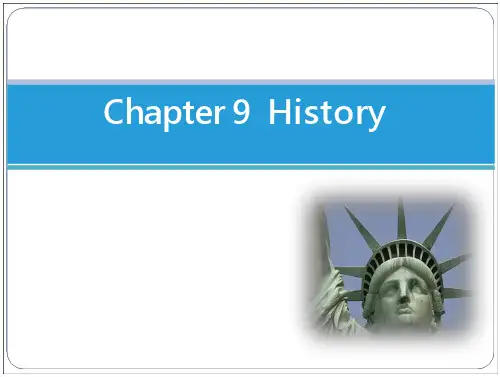
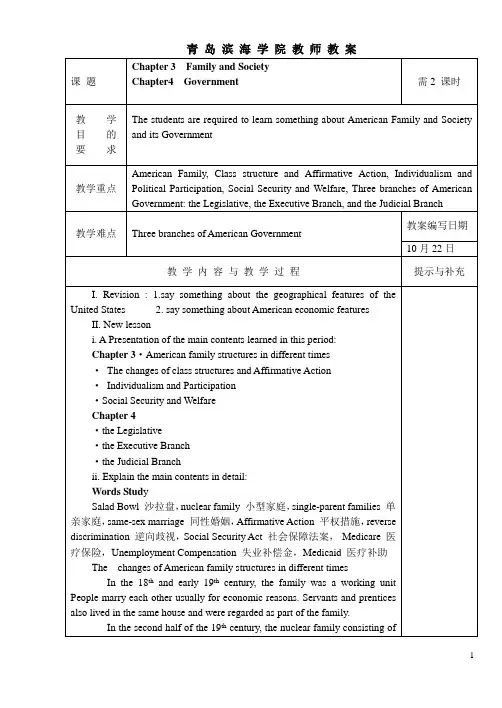
课题Chapter 3 Family and SocietyChapter4 Government 需2 课时教学目的要求The students are required to learn something about American Family and Society and its Government教学重点American Family, Class structure and Affirmative Action, Individualism and Political Participation, Social Security and Welfare, Three branches of American Government: the Legislative, the Executive Branch, and the Judicial Branch教学难点Three branches of American Government教案编写日期10月22日教学内容与教学过程提示与补充I. Revision : 1.say something about the geographical features of theUnited States 2. say something about American economic featuresII. New lessoni. A Presentation of the main contents learned in this period:Chapter 3·American family structures in different times·The changes of class structures and Affirmative Action·Individualism and Participation·Social Security and WelfareChapter 4·the Legislative·the Executive Branch·the Judicial Branchii. Explain the main contents in detail:Words Stud ySalad Bowl 沙拉盘,nuclear family 小型家庭,single-parent families 单亲家庭,same-sex marriage 同性婚姻,Affirmative Action 平权措施,reverse discrimination 逆向歧视,Social Security Act 社会保障法案,Medicare 医疗保险,Unemployment Compensation 失业补偿金,Medicaid 医疗补助The changes of American family structures in different timesIn the 18th and early 19th century, the family was a working unitPeople marry each other usually for economic reasons. Servants and prenticesalso lived in the same house and were regarded as part of the family.In the second half of the 19th century, the nuclear family consisting ofthe husband and wife and their dependent children became the model for most Americans. Servants and prentices no longer lived with the family. Love and affection became a very important part marriage.By the beginning of the 20th century, an ideal family was supposed to have a breadwinner husband, a domestic wife, and their children who attended school.Things began to change in the 1960s. The enormous materials wealth available to Americans in the 1950s and early1960s expanded the middle class. The idle middle class family is that the father knew everything, the mother was always cheerful and loving, and their children were respectful and did well in school. However, the enormous amount of wealth also caused people to believe in more equality and social justice. The generation growing up after World War II began to demand more self-fulfillment. African Americans waged the Civil Rights Movement against racial discrimination This had enormous impact on the family: more women began to take jobs outside home and to develop careers. As a result, divorce rate rose quickly in the 1970 and 1980s. The high rate of divorce and separation left many children living with one parent Most of the single-parent families are headed by women and have financial problems. The size of average American families is becoming smaller and smaller. During the 1960s and 2970s when the society as a whole was concerned about the rights of individuals, lesbians and gays openly demanded their rights to be respected, including the rights for people of the same sex to live together and get married. Although most people still oppose same sex marriage and most of the 50 states have laws that ban same sex marriage, the judicial branch is becoming more tolerant toward it.Class structures and Affirmative Actionthe reasons for the establishment of American class structureWhen industry developed in the late century, the middle class was mostly composed of the prosperous urban workers. After the Great Depression, the New Deal provided extra social protection for the middle class by adding programs like social security and Medicare. More than half of the American population claimed to belong to the middle class.However, from the late 1970s on, things have changes. The American society has become more polarized and the gap between the rich and the poor has become bigger than ever before because of the unequal distribution of the new wealth created by the technical revolution. Most of the wealth created by the technical revolution has gone to a small number of people who own the machines and capital. As more and more work in the manufacturing industryhas been replaced by machines and computers, a large number of high paying jobs disappeared. Most of the newly created jobs are in the service sector that usually pays low wages. This means that most of middle class people have not benefited from the increasing amount of wealth produced by the new technology.Wealth distribution in the U.S. is unbalanced. The top 20% of the population controls more than 80% of the nation’s wealth; while the bottom 40% of the population enjoys only 0.2% of the wealth. In American, 12.7% of the population fell below the federal poverty according to the statistic from United States Census Bureau in 2005.(2) The Class Structures in the USA·The richest people are owners of big businesses. Many of them are billionaires and multi-millionaires. They make up about 1% of the population.·Below them are the group of managers and chief executive officers (CEOs) of corporations and public organizations. Their annual income varies from hundreds of thousands to millions of dollars a year.·Then there are the professionals such as a successful doctors and lawyers whose annual income varies from $75,000 to hundreds of thousands a year.·Below this group are people of what is known as the new working class who are nurses, teachers, civil servants, small business owners, and unionized skill workers. Their incomes are from $30,000 to $50,000 a year.·About 50% of the population makes less than $30,000 a year. They work in clerical and sales jobs, personal services, transportation, or jobs with factory assembly lines.·At the bottom is the 10%-15% of the population who are unemployed or have temporary jobs. Many of this group live in poverty.(3) Affirmative ActionThe U.S. government has implemented affirmative action policies since the 1970s which favor minorities and women in hiring, promotion, college admission, and the awarding of government contract .3.Individualism and Political Participation(1) IndividualismIndividualism has been a very important ideology in American society. Individualism means self-fulfillment, self-expression, self-reliance, independence and responsibility.The interest groupsThe interest groups actively participate in the political process. They have political Action Committees which organize voters to vote for candidatessupporting their causes in all kinds of elections. They also have lobbyists to lobby the government for policies they like. They use the media to advertise their cause and hold demonstrations to protest against policies they don’t like. They also have grassroots organizations to get their message to the voters. Now, politics in America are no longer controlled by political parties though the parties are the main players in the political arena. Both of the major parties, the Republican Party and the Democratic Party have to pay attention to the demands of the major interest groups in order to win elections.The differences between the two partiesUsually, the Democratic Party believes that the government should play a role to promote economic growth by investing in education and social welfare while the Republican Party believes that economic growth comes not from government intervention but from individual enterprise. So the Republican Party usually favors the rich class by cutting their taxes. On welfare policy, the Democratic Party believes that no person who works should live in poverty and government should give them a second chance through welfare. The Republicans believe that it is the individual’s own responsibility to take care of themselves and blame welfare programs for individual’s lack of independence and for the breakdown of families. On education, the Democratic Party supports public schools and opposes school vouchers which allow people to use public money to go to private schools, while the Republicans support school vouchers. (为了逐步实现基础教育阶段的“教育公正”,美国自20世纪70年代开始了对“教育券计划”(政策)的论证和可行性研究。